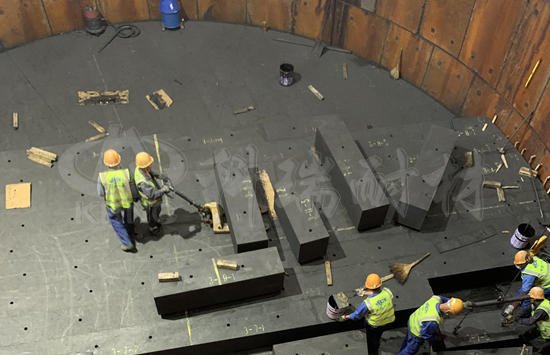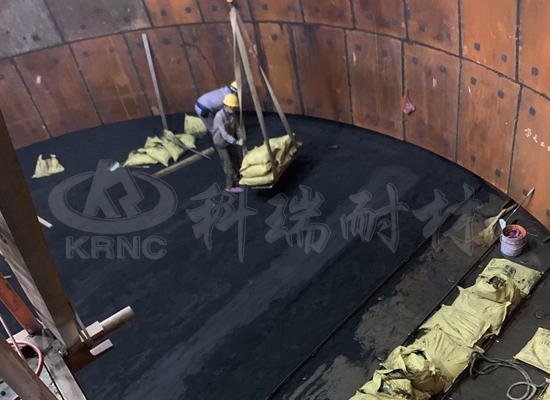
1. Preparation
Materials: Semi-graphite brick, microporous carbon brick ,ultramicroporous carbon brick ,microporous corundum brick ,silicon nitride combined with carbonized silicon brick ,phosphate impregnated clay brick, etc., the required refractory materials are prepared and stored properly.
Construction preparation:After the completion of welding and assembly of blast furnace shell group, the construction site should be cleaned up, spraying equipment adjusted, and scaffold erected.

2. Sketch
a. Furnace bottom
- Full carbon brick (there are two kinds of masonry technology: horizontal masonry and vertical masonry), masonry along the center line of the cross to both ends.
- The consistency of phosphate mud should be strictly controlled when clay bricks are dipped in phosphate mud for masonry.
- Ceramic bottom cushion construction (masonry technology has vertical cross shape and concentric circle ring), from the furnace body cross center line to ceramic cup wall or other masonry.

b. Hearth
- Carbon bricks are used to carry out annular masonry successively. When passing through the iron opening, the masonry should start from the iron opening, and ensure the passing size and verticality of the iron opening. The inner diameter of the masonry and the thickness of the brick joints should be checked at any time.


c. Cooling wall
- In joint pointing construction, support plate and small tamper are used to fill the tamping material into the ash joint. The filler is not allowed to fall into the gap between the cooling wall and the furnace shell. The filler should be full and full to avoid the leakage of grouting during pressure grouting of the furnace shell.

d. Construction of iron mouth tuyere combined brick
According to the center point, three lines are released, that is, center line of tuyerand iron mouth, center line of tuyerand iron mouth masonry edge line of blast furnace inner diameter circle line is constructed in accordance with three lines for control, check and adjust at any time, pay attention to check the inner diameter of hole mouth.
e. Bottom, waist and body
Furnace throat steel brick area filling construction, debugging good mixer vibrator, etc., according to the technology of homogeneous mixture ratio, poured into the cooling wall or steel brick, vibrating close-grained daub after surface is flat and level Between furnace shell and the cooling wall grouting construction, and then in the welded anchor construction, the application of spray coating on a reserved good juncture, as far as possible a reaches the designed thickness, too thick flat, surface finishing
3. Key points of construction quality
- For ramming material between cooling stave and carbon brick, the input is 100mm at a time to ensure the height requirement after construction.<50mm.
- When the construction of the ramming material reaches the horizontal plane about 50mm below the upper surface of each layer of carbon brick, the key parts such as the iron mouth and the elephant foot of the construction of this layer shall be sampled and tested for the density of the ramming material.
- After lifting hole cleaning, use round bar and hammer or small steam hammer for ramming material construction.
- Construction shall be carried out in accordance with the design drawings. The main national standard for construction and acceptance of industrial furnaces masonry engineering GB50211-2014 is the standard for quality acceptance of industrial furnaces masonry engineering GB50309-2017.
4. Remark
- If any abnormality is found in the construction process, it shall be reported to the technical chief engineer of Kerui’ technical staff in time to confirm the treatment plan and shall not be handled without authorization.
- The protection consciousness of the finished products of the refractory materials construction should be strengthened from the unpacking transportation to the construction.
- According to the refractory material each layer for an inspection batch for construction acceptance, strict acceptance of each process.


 Wechat Us
Wechat Us